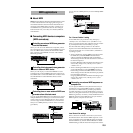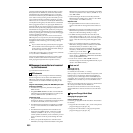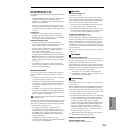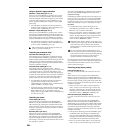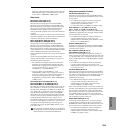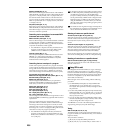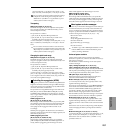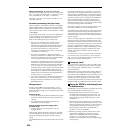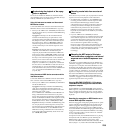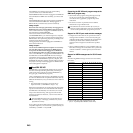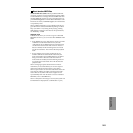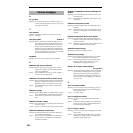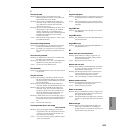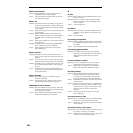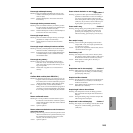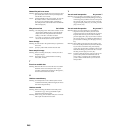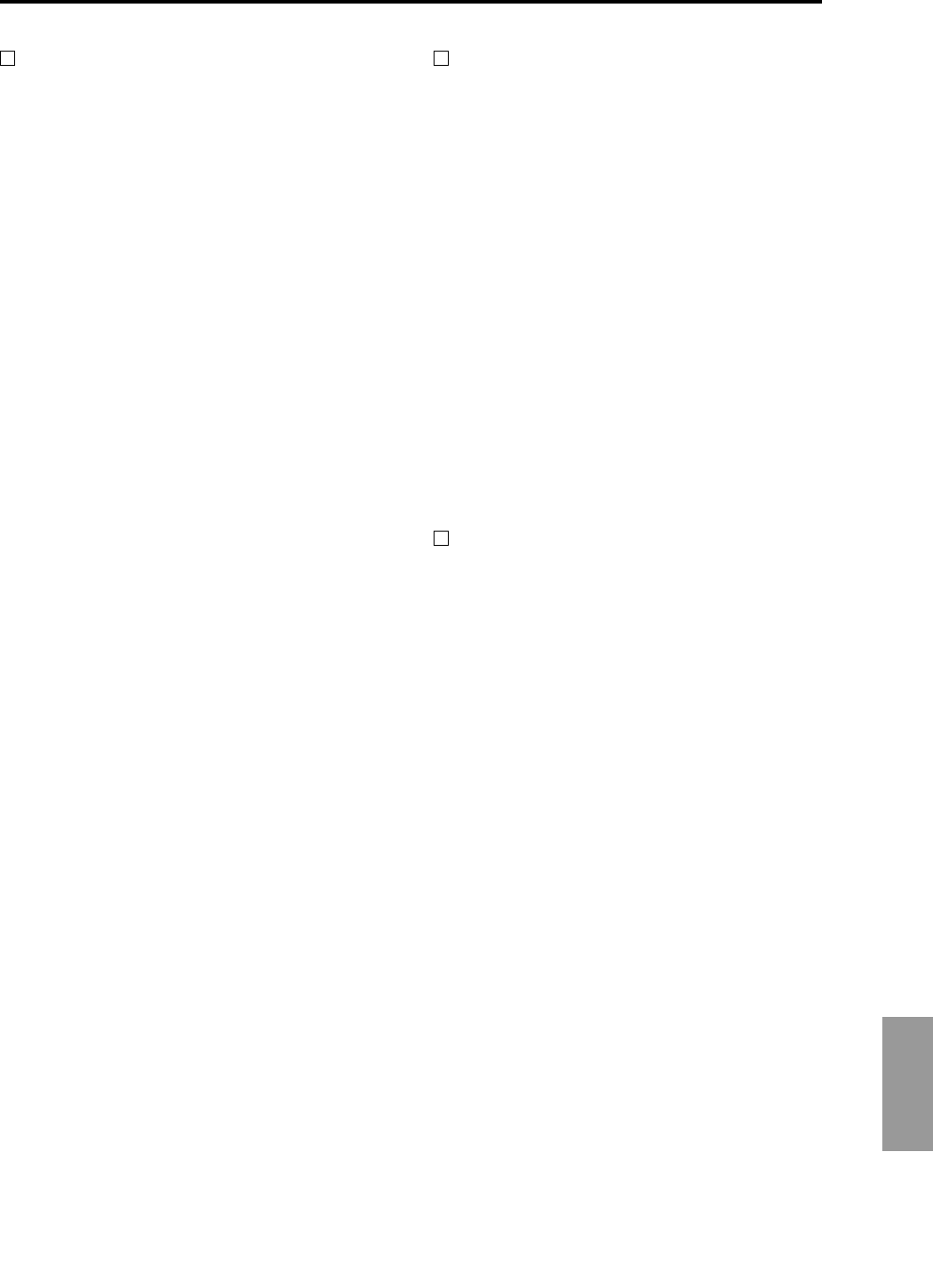
239
Appendices
Synchronizing the playback of the arpeg-
giator or sequencer
The choice of whether the TRITON Le will be the master
(the controlling device) or the slave (the controlled device) is
made by “MIDI Clock” (GLOBAL 2.1–1a).
Using this instrument as master and the external
MIDI device as slave
Connect the MIDI OUT connector of this instrument to the
MIDI IN connector of the external MIDI device. (☞p.231)
•When you set “MIDI Clock” to Internal, this instrument
will be the master device, and will transmit MIDI timing
clock messages.
Arpeggiator: The tempo can be controlled from this
instrument. Simultaneously, the performance of the
arpeggiator will be transmitted via MIDI. (In Combina-
tion, Sequencer modes, data will be transmitted by tim-
bres/tracks whose “Status” is BTH, EXT, or EX2.) An
external tone generator connected to MIDI OUT will
sound, and the tempo of an external sequencer can be
controlled.
Sequencer: The musical data can be played back and
controlled on the TRITON Le. Simultaneously, the
sequencer playback will be transmitted via MIDI from
tracks whose “Status” is BTH, EXT, or EX2. An external
tone generator connected to MIDI OUT will sound, and
the tempo of an external sequencer can be controlled.
However, since exclusive data cannot be recorded on the
TRITON Le’s sequencer, you can use the “Dump
Sequencer” (GLOBAL 2.1–1c) utility menu command if
the slave device is the TRITON Le. If the slave device is
another model, you can use the TRITON Le’s Media
mode data filer function (“Receive and Save MIDI Exclu-
sive,” “Load and Transmit MIDI Exclusive Data”).
(☞p.144, 150)
Using the external MIDI device as master and this
instrument as slave
Connect the TRITON Le’s MIDI IN connector to the MIDI
OUT connector of the external MIDI device. (☞p.231).
•When you set “MIDI Clock” to External, the TRITON Le
will be the slave device.
Arpeggiator: The tempo will follow the MIDI timing
clock. If you playback the external sequencer, the
TRITON Le’s arpeggiator will synchronize to the exter-
nal timing clock. (☞BG p.107)
Even if “MIDI Clock” is External and the TRITON Le is
being controlled from the external device, the perfor-
mance of the arpeggiator performance will still be trans-
mitted via MIDI. (In Combination and Sequencer modes,
the arpeggiator performance will be transmitted from
timbres/tracks whose “Status” is BTH, EXT, or EX2.)
Sequencer: The tempo will follow the MIDI timing clock.
You can play back an external sequencer, and synchro-
nize the sequencer to the MIDI timing clock that it trans-
mits. Even if “MIDI Clock” is set to External and the
TRITON Le is being controlled from an external device,
musical data will be transmitted by tracks whose “Sta-
tus” is BTH, EXT, or EX2.
Recording musical data from an external
device
There are two ways in which you can play back an external
sequencer and record its playback on this instrument.
• Set “MIDI Clock” (GLOBAL 2.1–1a) to Internal, begin
recording, and then start the external sequencer. With
this method, the MIDI messages will be recorded
without the two devices being synchronized. Since the
incoming musical data will simply be recorded, this
method allows the performance to be reproduced
faithfully, but since measure divisions etc. will not be
kept track of, this method is not suitable if you intend to
edit the data later.
• If you set “MIDI Clock” to External, the start of
recording and the tempo etc. will all be under the control
of the external sequencer. Since the two devices will be
synchronized during the recording process, measure
divisions etc. will be accurately preserved. (You will
need to set the time signature before recording.)
However, tempo changes during the performance will
not be recorded, so you will have to insert any tempo
changes later. For normal multi-track recording, you will
use this method. (☞BG p.80 “Multi (multitrack
recording)”)
Recording the MIDI output of this instru-
ment’s controllers, arpeggiator, and internal
sequencer on an external sequencer/com-
puter
If you wish to record the MIDI output of the TRITON Le’s
controllers, arpeggiator, and internal sequencer on an exter-
nal sequencer or computer and use the TRITON Le as the
monitoring and playback tone generator while you record,
you must turn off the TRITON Le’s Local Control setting
(“Local Control On” GLOBAL 2.1–1a), and set your external
sequencer/computer for echo-back (a function by which the
data received at MIDI IN is retransmitted without change
from MIDI OUT) so that the data from the TRITON Le’s
controllers, arpeggiator and internal sequencer will not be
applied in duplicate to the tone generator.
Using the REALTIME CONTROLS [1]–[4] knobs to
record MIDI control changes on an external MIDI
sequencer/computer
Set the TRITON Le to Local Control Off. Set the external
MIDI sequencer/computer to Echo Back On. With these set-
tings, recording and playback will occur correctly, and the
control changes will not be applied to the tone generator in
duplicate.
Recording the arpeggiator or RPPR function on an
external MIDI sequencer/computer
When the arpeggiator is on, playing the keyboard or operat-
ing the controllers of the TRITON Le will operate and con-
trol the arpeggiator. The arpeggiator will operate and be
controlled in the same way in response to MIDI messages
received at MIDI IN. The MIDI messages generated from the
arpeggiator will be transmitted from MIDI OUT according
to the Local Control setting (“Local Control On” GLOBAL
2.1–1a) as described below.
In Sequencer mode, when the RPPR function is on, playing
the keyboard will cause RPPR to operate. Similarly, the
RPPR function will also operate in response to notes
received on the MIDI channel of the track selected by “Track
Select” (SEQ 1.1–1c). Notes will be transmitted by RPPR



